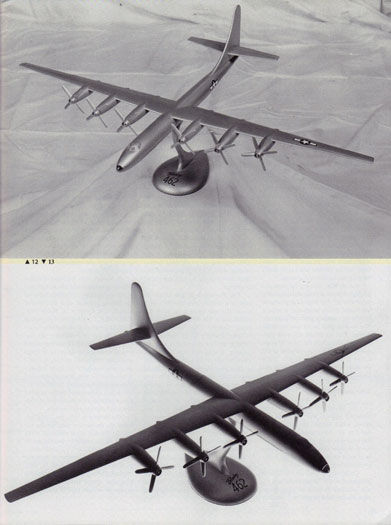S u m m a r y |
Title and Author: |
The B-52 Competition of 1946 ... and the Dark Horses from Douglas, 1947-1950. American Aerospace Archive 3. Aero Archive Press |
Media: |
Soft Cover, 60 pages |
ISBN: |
|
Price: |
US$14.95 from Aero Archive Press |
Review Type: |
First Read |
Advantages: |
A detailed examination of the 1946 USAAF heavy bombardment aircraft competition. This volume covers initial proposals plus the Douglas Aircraft studies intended to win the contract away from Boeing |
Disadvantages: |
None noted |
Conclusion: |
One for the aviation historian and enthusiast who wonders what might have been. Potential to plant the seed of an interesting what if design. |
Reviewed by Ken Bowes

HyperScale is proudly supported by Squadron.com
In 1946, the USAAF issued a request for proposals for a turbo-prop powered bomber that would be intended to replace the B-36 which had yet to enter service. While all designers were concerned the requirements were beyond the state of the art at that time, ultimately the Boeing Model 462 was chosen for further development.
 Looking more like an enlarged six engine B-29, the 462s successor would eventually enter service as the B-52 which remains operational to this day. In this magazine style book, author Jared Zichek examines the entire competition from its genesis, covering all the original proposals as well as the revised Douglas designs intended to win the contract away from Boeing. As a result design proposals examined include: Looking more like an enlarged six engine B-29, the 462s successor would eventually enter service as the B-52 which remains operational to this day. In this magazine style book, author Jared Zichek examines the entire competition from its genesis, covering all the original proposals as well as the revised Douglas designs intended to win the contract away from Boeing. As a result design proposals examined include:
-
Boeing Model 462 (the winner – 3 variants)
-
Convair Long Range Heavy Bombardment Airplane (forward swept wing bomber depicted on cover)
-
Martin Model 216 (”flying aircraft carrier” – 2 variants)
-
Martin Model 232 (description only)
-
Douglas Very Long Range Bomber C (VLRB-C – 2 variants)
-
Douglas Model 1112 (heavy bomber derivative of XB-42 – 3 variants)
-
Douglas Model 1155 (interim jet bomber derived from DC-6 – 2 variants) and
-
Douglas Model 1211 (giant swept wing turboprop bomber – 40 variants)
Drawing heavily on archival sources, Zichek describes each design and provides facsimiles of the general arrangement and other drawings along with contemporary models to describe each of the designs. Whilst clearly not intended for modelers, this book covers some interesting ground. As many modelers are also indeed aviation enthusiasts, it would not be far wrong to say that anyone with a passing interest in the history of USAF bombers and aerial bombardment in general would get something of interest out of this book.
Review Copyright © 2009 by Ken Bowes
This Page Created on 14 September, 2009
Last updated
14 September, 2009
Back to HyperScale
Main Page

|
Home
| What's New |
Features |
Gallery |
Reviews |
Reference |
Forum |
Search